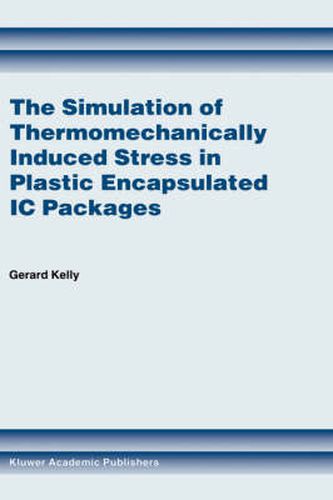Readings Newsletter
Become a Readings Member to make your shopping experience even easier.
Sign in or sign up for free!
You’re not far away from qualifying for FREE standard shipping within Australia
You’ve qualified for FREE standard shipping within Australia
The cart is loading…






This title is printed to order. This book may have been self-published. If so, we cannot guarantee the quality of the content. In the main most books will have gone through the editing process however some may not. We therefore suggest that you be aware of this before ordering this book. If in doubt check either the author or publisher’s details as we are unable to accept any returns unless they are faulty. Please contact us if you have any questions.
This study is motivated by the need to understand and predict the complex stress distributions, transfer mechanisms, warpage, and potential failures arising from the encapsulation of devices in plastic. Failures like delaminations, package cracking, and metal shift occur due to the build-up of residual stress and warpage in the packages because of the TCE mismatch between the package materials as the package cools from its moulding temperature to room temperature. The correct use of finite element tools for these problems is emphasised. Finite element techniques are used to predict the internal package stress distribution and help explain the stress transfer mechanism between the die, die paddle, and plastic after moulding. Out-of-plane shear stress components are shown to be responsible for experimentally observed metal shift patterns on the die surface. Delaminations dramatically alter the internal stress state within a package, increasing the tensile stress in the plastic and so the likelihood of plastic cracks, the stress on wire bonds, and the incidence of wire bond failure. The application of finite element techniques to predict the post-mould warpage of both thermally enhanced PQFPs and TQFPs is described. Simulations of a thermally enhanced PQFP warpage based on standard modelling assumptions alone fail to predict either its magnitude or its direction correctly. The modelling assumptions need to be modified to include the chemical shrinkage of the moulding compound to enable accurate predictions of package warpage to be made, particularly when the packages are asymmetric in structure. Microsystem packaging in both plastic and 3D package body styles is reviewed. Although microsystem packaging is derived from IC packaging, additional requirements for microsystems not common to IC packaging are highlighted. The assembly stresses on a novel microsystem, incorporating a micromachined silicon membrane pump integrated into a 3D plastic encapsulated vertical multichip module package (MCM-V), are analysed.
$9.00 standard shipping within Australia
FREE standard shipping within Australia for orders over $100.00
Express & International shipping calculated at checkout
This title is printed to order. This book may have been self-published. If so, we cannot guarantee the quality of the content. In the main most books will have gone through the editing process however some may not. We therefore suggest that you be aware of this before ordering this book. If in doubt check either the author or publisher’s details as we are unable to accept any returns unless they are faulty. Please contact us if you have any questions.
This study is motivated by the need to understand and predict the complex stress distributions, transfer mechanisms, warpage, and potential failures arising from the encapsulation of devices in plastic. Failures like delaminations, package cracking, and metal shift occur due to the build-up of residual stress and warpage in the packages because of the TCE mismatch between the package materials as the package cools from its moulding temperature to room temperature. The correct use of finite element tools for these problems is emphasised. Finite element techniques are used to predict the internal package stress distribution and help explain the stress transfer mechanism between the die, die paddle, and plastic after moulding. Out-of-plane shear stress components are shown to be responsible for experimentally observed metal shift patterns on the die surface. Delaminations dramatically alter the internal stress state within a package, increasing the tensile stress in the plastic and so the likelihood of plastic cracks, the stress on wire bonds, and the incidence of wire bond failure. The application of finite element techniques to predict the post-mould warpage of both thermally enhanced PQFPs and TQFPs is described. Simulations of a thermally enhanced PQFP warpage based on standard modelling assumptions alone fail to predict either its magnitude or its direction correctly. The modelling assumptions need to be modified to include the chemical shrinkage of the moulding compound to enable accurate predictions of package warpage to be made, particularly when the packages are asymmetric in structure. Microsystem packaging in both plastic and 3D package body styles is reviewed. Although microsystem packaging is derived from IC packaging, additional requirements for microsystems not common to IC packaging are highlighted. The assembly stresses on a novel microsystem, incorporating a micromachined silicon membrane pump integrated into a 3D plastic encapsulated vertical multichip module package (MCM-V), are analysed.